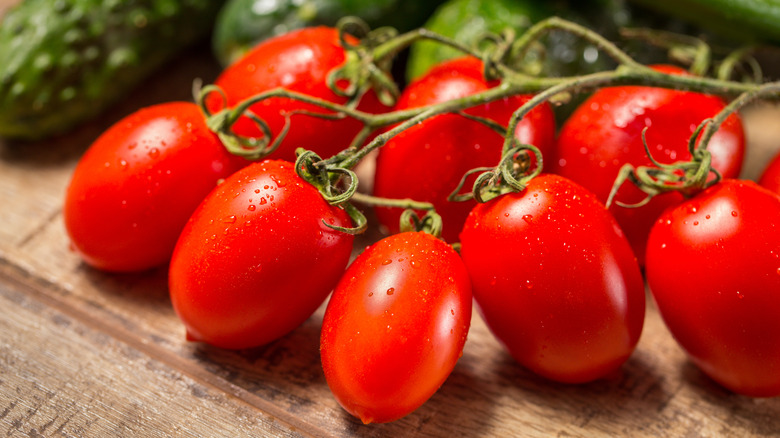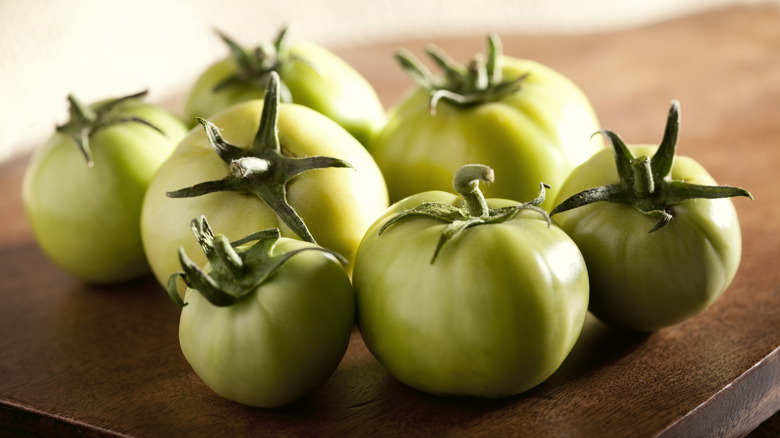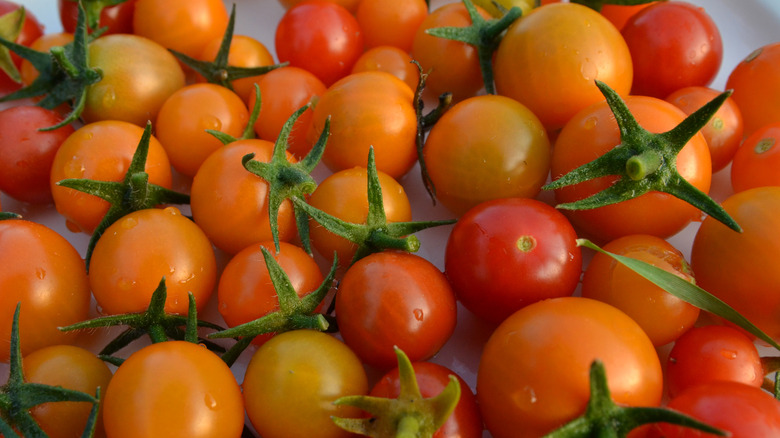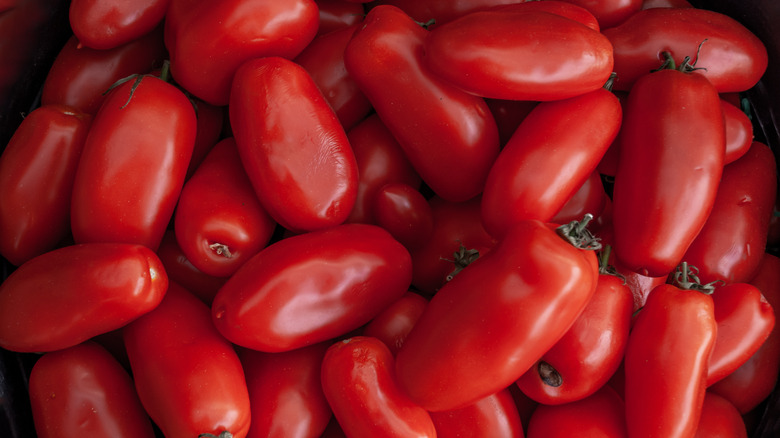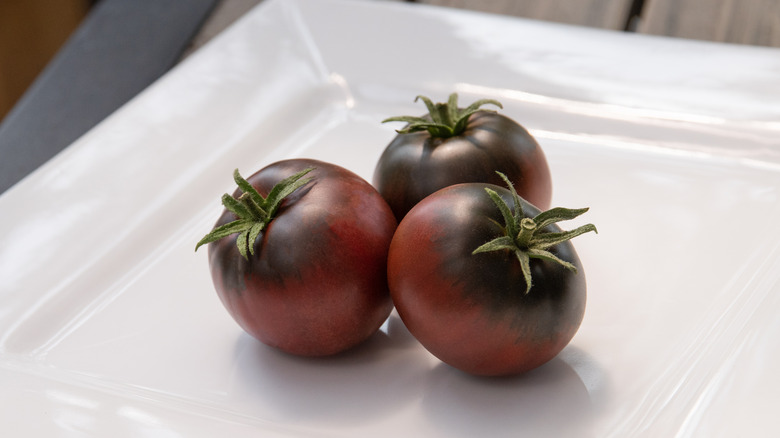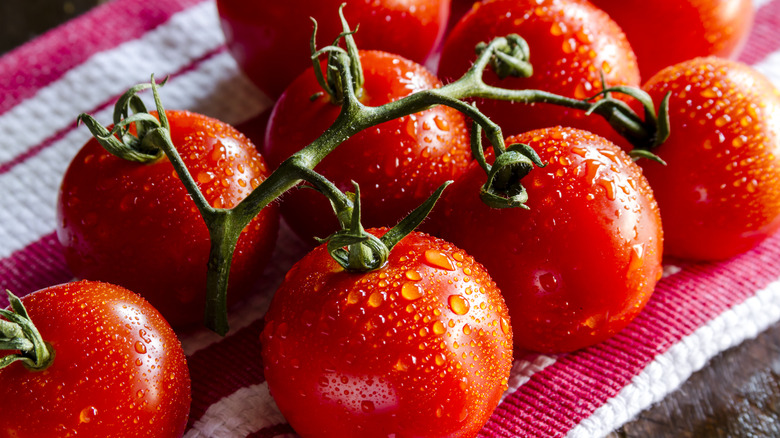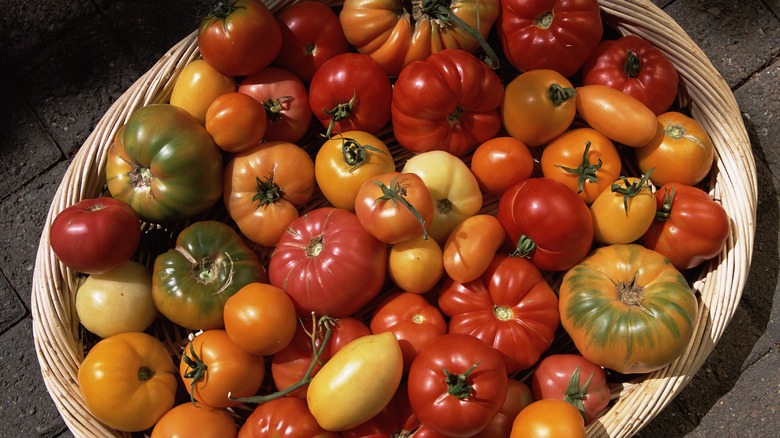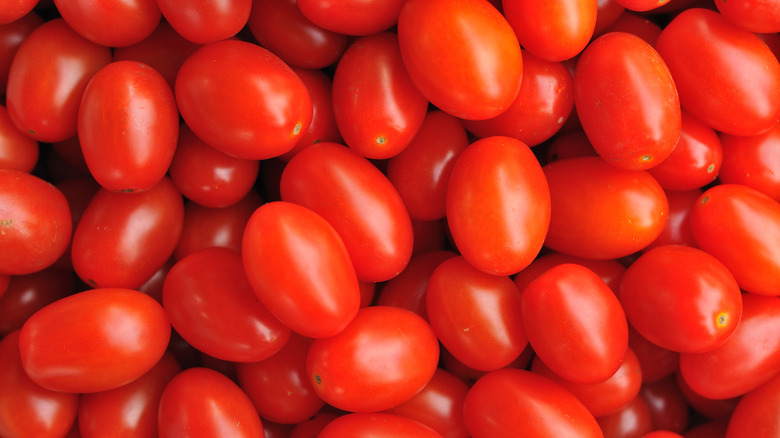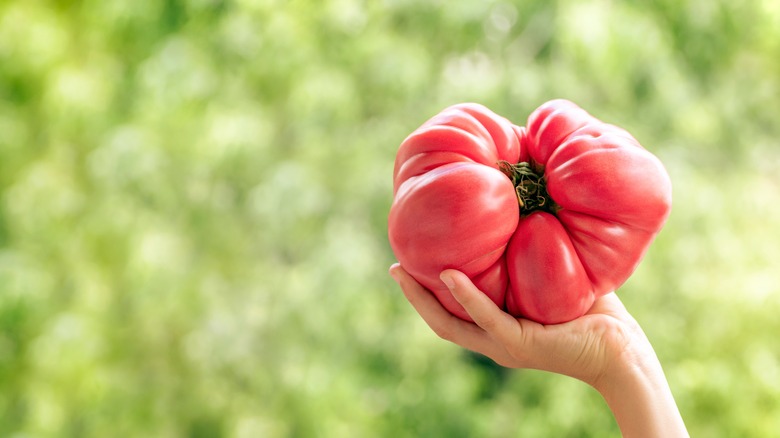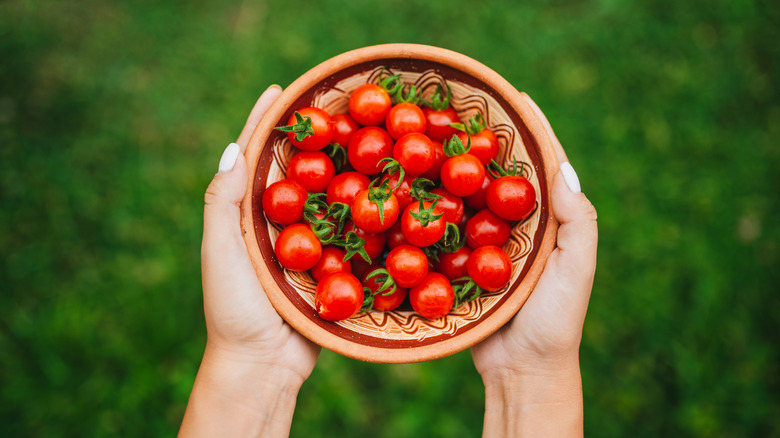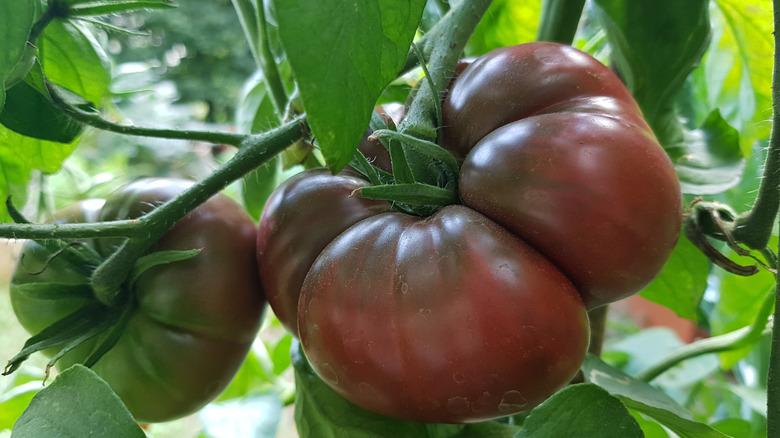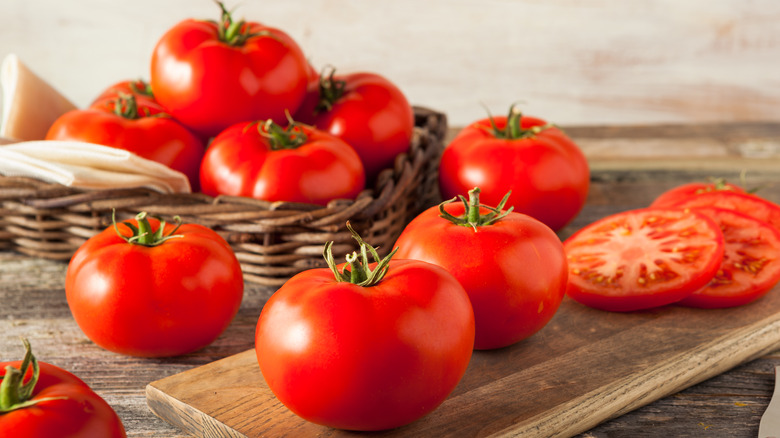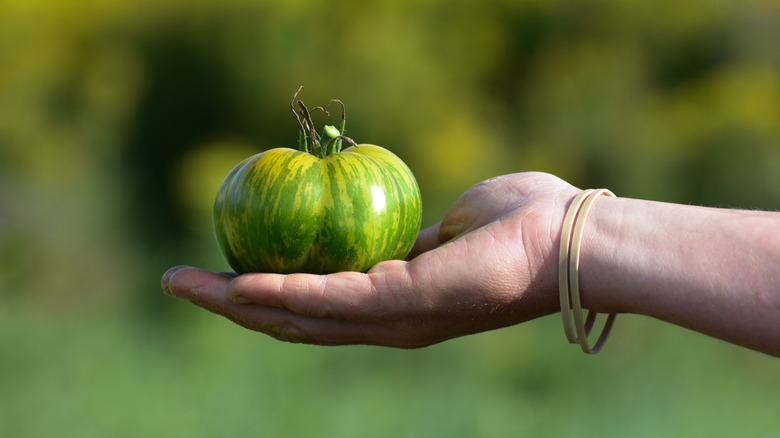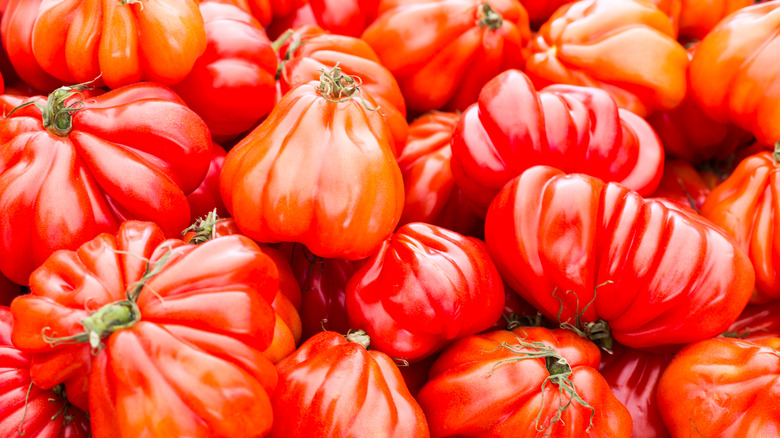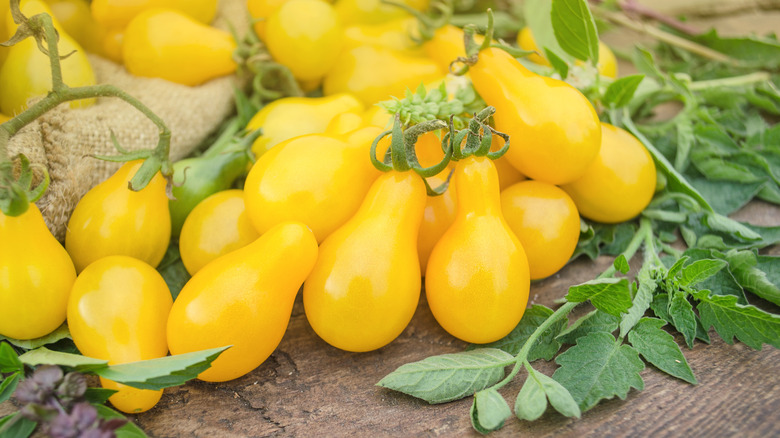16 Tomato Varieties You Might Not Be Aware Of
Tomatoes, beloved for their vibrant flavors and versatile culinary applications, come in an array of varieties beyond those with which you're most familiar or those you see at the grocery store. From the classic beefsteak tomatoes, known for their substantial size and juicy flesh ideal for slicing, to the sweetness of cherry and grape tomatoes that pop with flavor, the kind of tomato you use makes a big difference, and it's worth knowing which variety would best suit your recipe.
Roma tomatoes, celebrated for their meatiness and minimal seeds, find their calling in sauces, while heirloom varieties, with their rich histories and unique appearances, give a nod to Italian tradition. After all, once tomatoes were brought from Mexico and what is now Peru all the way to Italy, the use of tomatoes in cuisine became the norm across the world. Now, there are thousands of types of tomatoes that sprouted from the original, wild cultivars. Here, we'll explore some varieties you might not have known before but should certainly learn about.
1. Roma
Often found in grocery stores, Roma tomatoes are renowned for their meaty texture, low seed count, and rich, slightly sweet flavor. While they descended from the Italian San Marzano tomato, Roma tomatoes were actually bred by the USDA In 1955. Sometimes, they are referred to as "plum tomatoes" because of their oblong, oval shape. These tomatoes are a popular choice for making sauces, pastes, and canning because they have thick flesh and less juice than other varieties, contributing to a concentrated flavor and less liquid once they're cooked down. Typically, this cultivar has fewer seeds, which prevents a lot of hassle in the kitchen.
If you want to try planting them at home, Roma tomatoes are relatively easy to grow and are favored by home gardeners for their high yields, compact growing, and general disease resistance. They thrive in warm climates and require ample sunlight and well-drained soil. With a vivid red color when ripe, they are also used fresh in salads and sandwiches, although their firm texture differs from other tomatoes.
2. Green
Perhaps known best for their use in the ultimate comfort food, Southern-fried green tomatoes, this variety is just an underripe tomato that was picked before gaining its full color. Yet some green tomato varieties, like Green Zebras, get their vibrant, green color once completely ripe. When you think of the classic fried dish, however, it's typically a red tomato variety that was picked early on. Because they are unripe, they are less juicy with a tart, crunchy bite, which definitely makes them ideal for frying — it means they can stand to be battered and dropped in oil without losing their shape or falling apart completely.
Although the 1991 film has many of us convinced they should only come fried, these tomatoes can be incorporated into many recipes. Surprisingly, they make a delicious green tomato pie and are also perfect for casseroles, relishes, and pickling. When you look for them at the store, make sure not to confuse them with tomatillos, which are often known as Mexican green tomatoes and are very different in texture and taste.
3. Sungold
Found in local farmer's markets and grocery stores, sungold tomatoes are a type of cherry tomato with distinct orange coloring and a sweet flavor. Bred in Japan, this hybrid has gained a lot of popularity because of its intense burst of flavor. Even before reaching full ripeness, they have a candy-like sweetness that sets them apart. As they mature, their flavor is often considered citrusy or tropical. Their unique taste and small size distinguish them as some of the best-tasting tomatoes, ideal for snacking or topping salads.
Sungold tomato plants are indeterminate, which means they continue to produce fruit throughout the growing season, making them a prolific plant for gardeners. If you grow them yourself at home, you're looking at a high-yield crop, especially if they're given plenty of water and sunlight. But even if you accidentally neglect them, these tomatoes do really well in gardens. Because of this, it's no surprise that we're seeing them more regularly in supermarkets that get their produce from local farmers.
4. San Marzano
Of the several Italian tomato varieties, San Marzano tomatoes are an absolute favorite, and with good reason. Not only do they have a bold, sweet flavor, but they are known to create the most delectable sauces. Easily considered a gourmet tomato, San Marzanos are authentic to Italian cuisine. Sometimes, they are compared to Roma tomatoes, another kind of plum tomato, but the San Marzano is decidedly different. Both are preferred for making sauces because they have less liquid, which means they won't produce a watery sauce. But San Marzanos have a more complex flavor and are fleshier, gaining superiority, particularly in Italian recipes.
Because they thrive in Italy's soil, you really can't find authentic San Marzano tomatoes outside of the country. Yet they can be bought and are often found canned whole. However, if they were grown outside of the Italian region, they might not be labeled as DOP, which stands for Denominazione d'Origine Protetta, translated as "protected designation of origin." Although some cans won't be marked this way, the DOP label on tomatoes says a lot about what's inside. It's mainly about quality control – it states where and how they were grown as a testament to their authenticity and most optimal flavor, and anything outside of this designated growing area will essentially be a copycat, but not the real deal.
5. Cherokee Purple
As its name suggests, the Cherokee Purple tomato is said to have originated as a gift from the Native American Cherokee tribe to a farmer in Tennessee back in the early 1900s. It is known for its deep, reddish-purple color. With their sweet, smoky flavor, these tomatoes are perfect for grilling, sauteeing, and roasting. That kind of versatility also makes them ideal for topping pizza or pasta. These tomatoes are also suitable for slicing because of their classic sweet and acidic taste, so they'll find a nice place on your sandwiches, too.
This heirloom variety has gained popularity among home gardeners, farmers, and tomato lovers alike for its historical significance, striking appearance, and flavor profile. While Cherokee purple tomatoes are simple enough to grow and can be found at farmers' markets, you're unlikely to find them anywhere else. Still, they are worth trying should you come across them to buy or want to try your hand at planting them.
6. Campari
A modern hybrid variety, Campari tomatoes are characterized by their small size, exceptional sweetness, and vibrant red color. Somewhat larger than cherry tomatoes but smaller than traditional slicing tomatoes, they are juicy and tender with a well-balanced sweetness and subtle acidity. Much like cherry tomatoes, Campari tomatoes are popular for making bruschetta, simple snacking, topping salads, and garnishing dishes or drinks, but they can also be cooked. Since their flavor develops even more with heat, they are also a great tomato for roasting, grilling, stuffing, or making sauces.
They are often sold on the vine year-round but aren't considered an 'on the vine' tomato — they're actually known as cocktail tomatoes. Because of their wide availability, convenience, and perfectly tomato-y flavor, they are often found in both home kitchens and restaurants. Campari tomatoes exemplify modern breeding techniques that prioritize flavor while delivering what tomato lovers want most: a simple snack or a perfect pop of flavor.
7. Heirloom
Just as the word "heirloom" suggests, this variety of tomatoes is simply a tomato seed that has been passed down through generations, evolving with each harvest and reaching its fullest potential as the years go by. "Heirloom tomatoes" is essentially an umbrella term for any tomato variety that fits the bill, so they'll come in varying colors, sizes, and flavors. You can use them for any sort of cuisine or recipe, but heirloom tomatoes have made their mark in gourmet restaurants for their authenticity and heritage.
There's no easy way to walk into a farmers' market and glance at a red or yellow tomato and assume it's an heirloom. It usually takes reading labels and learning about which tomato seeds have crossed through time. Even so, some markets will label tomatoes as heirlooms when they don't meet the requirements — they might be a new, local heirloom, but have they developed throughout the generations? It helps to know which heirloom tomatoes you're likely to come across. That way, you can differentiate between true heirlooms and ones incorrectly categorized as such. Some common heirloom varieties include Brandywine, Caspian Pink, Indigo Rose, Green Giant, Black Krim, and Italian Costoluto Genovese tomatoes.
8. Grape
Somewhere between cherry tomatoes and plum tomatoes, grape tomatoes find their place. They aren't quite as large as cherry tomatoes — if large is even a good word for the bite-sized variety — and they have an elongated shape, much like plum tomatoes. Unlike cherry tomatoes, the grape variety has thicker skin with meatier flesh inside. So not only can they stand up to a kitchen blade, but they're also optimal for roasting and grilling. Plus, they aren't as watery as some other small varieties, which helps when cutting and cooking them and also when storing and shipping them. Because of that and their general popularity, grape tomatoes are conveniently sold in stores throughout the year.
You may wonder if there's really a difference between cherry and grape tomatoes, and besides their size and texture, most of the deviations come down to small nuances of flavor, coloring, and shape. Grape tomatoes aren't quite as sweet as cherry tomatoes, but they still pack a punch of rich, tangy, and savory flavor in a small bite. Like other tiny tomatoes, they're incredibly versatile in recipes. Toss them in pasta or salads, slice them for sandwiches, or snack on them as is — grape tomatoes are ideal for just about anything.
9. Brandywine
Reigning supreme among heirloom tomatoes is the Brandywine variety. With its sharp aroma, robust flavor, voluptuous size, and beautiful coloring, this tomato has been cherished for well over a century. While its definite origins remain hazy, it's been speculated that Brandywine tomatoes date back to the late 1800s, as a true American heirloom passed down for generations until its first listing during the 1980s helped jumpstart the tomato's popularity. Notably, what makes Brandywine tomatoes so special is their heirloom status and their unique taste — they have that classic, tomato-y flavor while being both sweet and spicy.
Aside from being considered one of the most delicious heirloom tomatoes, Brandywine tomatoes are also a type of beefsteak tomato. This means they're full-bodied and perfect for slicing. They come in a few subvarieties and shades, such as pink, yellow, orange, or even black Brandywine tomatoes. During their harvest season, you may find these beauties in local farmer's markets or even grocery stores, but they aren't often readily available commercially.
10. Cherry
While cherry tomatoes come in multiple colors, such as the orange-ish Sungold variety, those you see in stores are likely bright red and perfectly round — which is how they got their name. As Smithsonian Magazine tells it, these tiny tomatoes were bred specifically during the 1970s by British growers and Israeli scientists after they made their way from Mexico and Central America. Like most tomato breeders, they hoped to produce a small tomato that could be commercialized with a longer shelf life. Beyond their efforts to bring us the cherry tomato we see most often today, the variety's origins remain divided. In most cases, poor soil and growing conditions contributed to other countries believing they first produced these snack-sized tomatoes.
No matter where cherry tomatoes first popped up, they are now among the most popular tomatoes you can buy because of their availability, deliciously juicy flavor, and versatility in main courses and hors d'oeuvres alike. Besides being excellent for caprese bites, they also give a perfect pop of flavor and color to pasta, salad, salsa, and more. You'll find many cherry tomato brands at supermarkets, grocery stores, and farmer's markets all year round.
11. Early Girl
Named for how early they ripen, Early Girl tomatoes are a modern hybrid variety that made its way to America after being developed in France in the 1970s. Typically, Early Girl tomatoes are a bright shade of red and have a round, slightly flattened shape, distinguishing them as slicer tomatoes. These kinds of tomatoes are known for being easy to slice for sandwiches while having a robust flavor. While Early Girls aren't as large as some other slicer tomatoes, like hearty beefsteak tomatoes, they are celebrated for their reliability in gardens and their balanced sweetness and tanginess.
Early Girl tomatoes are definitely ideal for slicing onto sandwiches, but they also are great for adding to salads, simmering, or sautéing because of their versatile size and flavor. Like all tomatoes, Early Girls are a healthy source of nutrients and vitamins, but this variety, in particular, is known to be rather high in vitamins A and C.
12. Black Krim
A distinctive heirloom variety, Black Krim tomatoes are named for their color — a deep mahogany with green and red undertones so dark that it appears black. Their flattened, slightly ribbed shape adds more uniqueness to their already intriguing history and appearance. Coming all the way from the Crimean ("Krim") peninsula on the Black Sea, they are known to taste salty, sweet, and acidic. They're perfect for slicing, eating raw, or making sauces. Even though they might not provide vibrant color to your dishes as common, brightly-hued tomatoes would, they will give recipes a visible twist.
Of the many black tomatoes (and there are several!), Black Krims are by far the most popular. They've been compared to beefsteak tomatoes because of their substantial size and use for slicing, but they're also somewhat similar to Cherokee Purple tomatoes in terms of their coloring. While the Cherokee Purple variety has a smokier flavor, Black Krims are sweeter.
13. Beefsteak
Notable for their massive size and bold flavor, beefsteak tomatoes are one of the most loved slicer (or sandwich) tomatoes. These heirloom tomatoes, named for their resemblance to beefsteak cuts of meat, can weigh a pound or more. Their rich, juicy, and meaty flesh is prime for dressing sandwiches, burgers, and salads. In fact, other tomato varieties that have similar qualities are also coined as beefsteak-type tomatoes, all because of this cultivar. Their flavor ranges from sweet to tangy, with a classic tomato taste. Because they are so hearty, they are frequently used for stuffing, grilling, and roasting.
If you're growing tomatoes in your own garden, this variety needs focused care but will not disappoint during harvest — they grow exceptionally tall. Beefsteak plants are indeterminate, so they'll produce fruit throughout the growing season. Like other dependable varieties, they thrive in warm climates with full sunlight and well-drained soil, but they can take a while longer to grow. Although beefsteak tomatoes are heirlooms, there are hybrid seeds you can buy that aren't as tedious when growing them yourself.
14. Green Zebra
You've seen green, yellow, and even black tomatoes, but have you seen striped ones? For a few decades now, Green Zebra tomatoes have been gaining more attention for their green and yellow striped body. Some call them heirlooms because of their uniqueness, but they're definitely a modern sort of hybrid that just has qualities that could lead to them becoming an heirloom. Since their origin only dates back to sometime between the 1970s and 80s, they haven't been cultivated for long enough to be considered a heirloom. Nonetheless, it's likely Green Zebras will be deemed as such as more years go by.
As far as their flavor and texture, they offer a little of everything you want in a tomato. They're tart, tangy, and fleshy enough to withstand slicing, grilling, sautéing, and everyone's favorite — frying. Even better, try them sliced and fried on a "BLT" sandwich. You might not find them in supermarkets as often as in farmers' markets, but if you happen upon a green, striped tomato, make sure to give these a try.
15. Oxheart
With origins tracing back to Europe, Oxheart tomatoes are recognized for their large size, ribbed body, robust texture, and sweet taste. Today, they are popular throughout France and Italy, though they were first heard of in Russia around the turn of the 20th century, according to Plantura. In general, their true origin is indefinite — Victory Seeds claims they date back to around 1926 when they were debuted by the Livington Seed Company. Either way, their lengthy heritage and individuality classify them as heirlooms.
As its name depicts, oxheart tomatoes look much like a bull's heart. When ripe, they are often vibrant red or pink, and their flavor profile ranges from mild and slightly tangy to intensely sweet, depending on the specific variety. Some subvarieties, however, deviate from reddish hues. For instance, White Oxheart tomatoes are light yellow, appearing nearly white. Known for their versatility, these beefsteak-type tomatoes are excellent choices for slicing, grilling, and sauces because they have minimal seeds and ample flesh that cooks down perfectly.
16. Yellow Pear
This heirloom cherry tomato gets its name from its appearance — Yellow Pear tomatoes look remarkably like little, bright yellow pears. This cultivar is said to have come from Europe long enough ago to land its rightful place as an old heirloom, although where in Europe is still debated. Minneopa Orchards states they were first documented in 1805 by German mycologist, Christiaan Hendrik Persoon, while CC Grow says they made their way to Europe by way of Spanish conquistadors. Nevertheless, most agree these yellow beauties have been around since at least the 1800s and are just as popular today.
In a bite that's no longer than your finger, Yellow Pear tomatoes have a fresh, mild flavor inherent to tomatoes. Also, as their name suggests, they tend to border on sweet and fruity. Favored by gardeners and home cooks alike, their miniature size and beautiful coloring make them a popular choice for garnishes, appetizers, salads, roasting, and good ol' snacking. Additionally, their uniqueness and visual appeal can add elegance to gourmet dishes or colorful vegetable medleys.

